
I spent about 7 years reviewing just digital gear as Editor of AudioStream. Streamers, servers, DACs, software, and cables filled my days, nights, and nightmares with the ever elusive goal of making digital music sound like just music, minus the digital part.
And in all that time including up to the present, there have been a handful of products that stand out in this regard, making stored and streamed music sound like just music—the DACs from totaldac, dCS, and Mola Mola along with network players/streamers like the discontinued dCS Network Bridge, the EMM Labs NS1 Streamer, and the Auralic AIRES G1.1.
The Grimm Audio MU1 Music Player, that acts as music server running Roon Core and music streamer running as Roon Ready endpoint, leaps onto the top of this short list of digital gear that acts as part of a system delivering just the music in all its power and glory.

I mainly paired the MU1 with the Barn resident totaldac d1-unity (review) and Mola Mola Tambaqui (review) DACs and the recently reviewed Jay’s Audio CDT3-MK3 CD Transport as part of a system that included the Soulution 330 integrated amplifier (more info) driving the Rockport Atria II (more info). Cables and power conditioning are all AudioQuest (full system and Barn details).
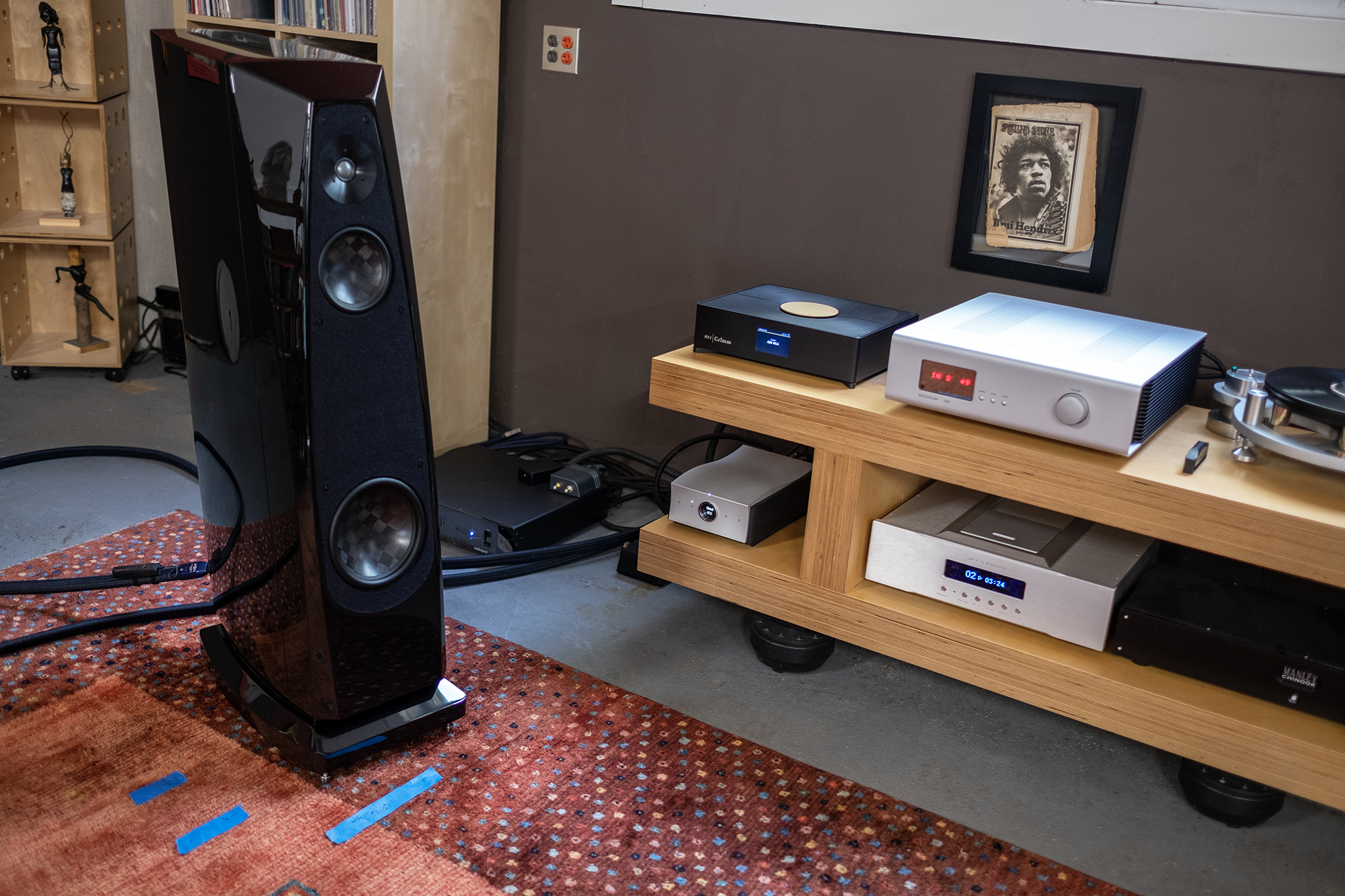
If we look back past my AudioStream days, I started writing about hifi in 2005 and I bring this up because in that time, in my 18 or so years of reviewing time, I have never had the opportunity to live with as resolving and musically breathtaking a system. And when music replay hits this level of performance, this level of astounding coherence, every piece of the system puzzle has an important role to play. You could even say ‘critical’ if you are anything like me and find listening to music to be an essential ingredient in a happy, healthy life.
Truth be told, this review could have been written much sooner in the MU1’s two-month Barn stay because I could hear its influence in this system soon after it took up residence therein. And this influence was most notably heard as increased resolution, finer and more finessed fine-grain detail, greater tonal saturation, increased dimensionality to the things making music, and a more precise and dimensional place for music to unfold within. Within this system context, these improvements with the Grimm MU1 acting as Roon Server and endpoint feeding the totaldac or Mola Mola via AES were heard and more importantly felt as important changes for the better. Changes that brought music to richer, fuller life in Barn through this system allowing for a seamless connection to whatever music I sent its way. All in all, pretty damn spectacular.
From Grimm:
With the MU1, our goal was to set a new benchmark in music player design. The Linux-based computer system brings solid data integrity. Our in-house-designed FPGA interface board, which forms the heart of the MU1, offers breakthrough performance levels in format conversion and receives automatic updates whenever we have pushed the boundaries again. Needless to say, the MU1 features our trademark ultra-low jitter clock. This is a music player worthy of the name Grimm Audio.
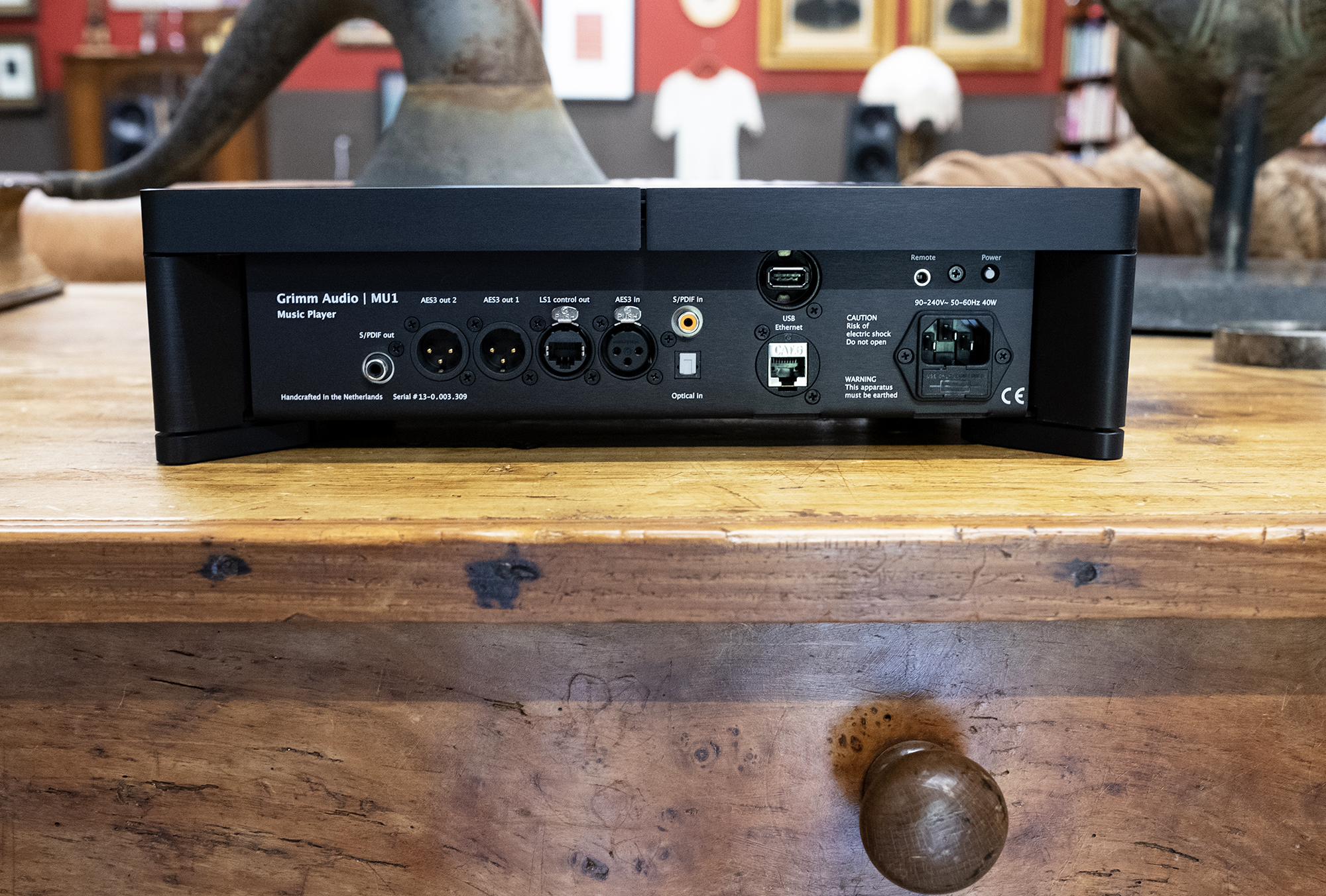
Inside the Grimm MU1’s quietly lovely chassis resides an Intel i3 CPU, the aforementioned ultra-low jitter clock and FPGA that performs a number of tasks including optional 2x and 4x upsampling of incoming data. As previously mentioned, the Grimm Audio MU1 can function as a Roon Core and Roon Ready endpoint, sending out digital audio via Coax S/PDIF or 2x AES/EBU to your DAC of choice. There’s also an RJ-45 based LS1 Control Out to connect the MU1 to Grimm’s LS1 Active Loudspeakers. Network connectivity is accomplished via Ethernet, there’s no WiFi herein, and three digital inputs (AES, Coax, Toslink) are on offer along with a USB input for connecting USB storage, a 3.5mm socket for an external IR remote, an IEC inlet for power, and a tiny, little power button. Why is it tiny and little and in such a hard to reach place? Because you want leave the MU1 powered on and ready for action.
The review sample arrived with the optional 2TB of internal SSD storage, an 8TB SSD is also available, so I loaded it up with a bunch of my music in file form. This was accomplished by connecting to the MU1 from my iMac (Go > Connect to Server) then dragging and dropping the music files into the Grimm. Easy peasy. I will note that my entire music library adds up to less than 2TB of storage space, this whittled down from many more albums, songs, and terabytes over the years. Yes, my digital music library has shrunk over time, call me a rebel, yet I listen to more music that’s new to me than ever before. Life is good.
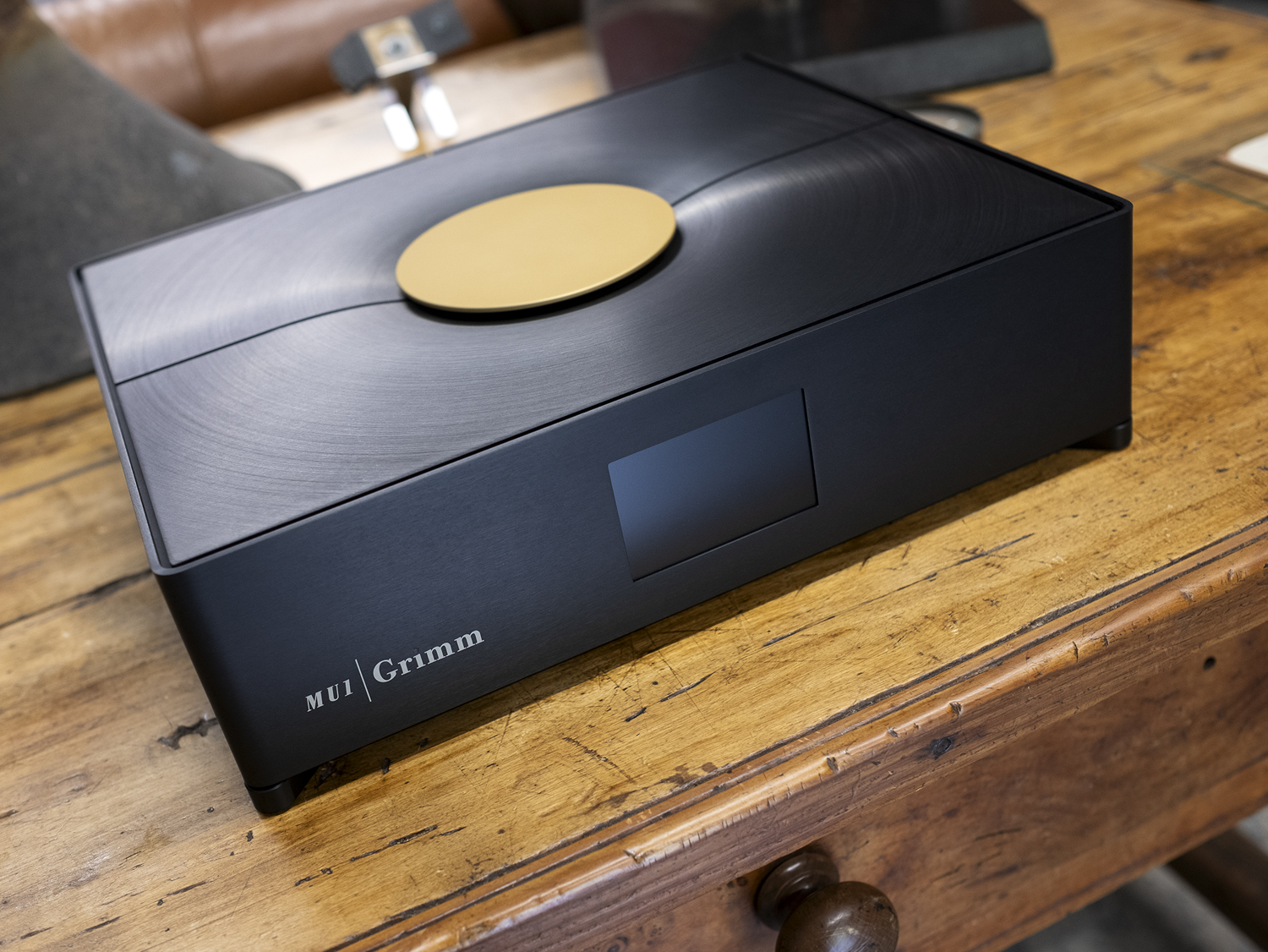
The golden disc up top is a multi-function control knob and you can also use the spartan browser-based Grimm app to control volume, input selection, and accessing menu selections including upsampling all data (2fs/4fs). Beyond the company logo that cleverly includes an activity display LED doubling as the dot on the “i” in Grimm, a centered 3.5″ full color TFT screen completes the lovely simple MU1 looks. The MU1’s black brushed aluminum chassis with that gently sloped (and kinda sensuous) top is the work of industrial designer Michiel Uylings.

During the course of this review, I had a conversation with Eelco Grimm, co-owner and Creative Director at Grimm Audio, and John-Paul Lizars, Sales Director North America. I’ve known John-Paul for a few decades and the majority of our conversations have centered on music we enjoy. Here, the topic was the MU1 and the main takeaway points for me were Eelco stressing the importance of the team that’s behind the MU1, where every part is produced by a specialist, and measurements are an essential aspect of the design process. I asked a general question about ‘noise’ because I know there are people out there, you know audiophiles who have strong opinions about everything, who are concerned about housing a server and a streamer in the same box, and Eelco’s response was measurements inform their design and implementation decisions so they know there are no noise issues in the MU1. Matters of fact can be, should be, more than welcome.
I have purposely only very lightly skimmed the tech surface of the MU1 because in my experience the tendency to think we know more than we know is preternaturally profound when it comes to digital audio and its replay, and the last thing I want to do is lay a breadcrumb trail that leads readers away from the purpose of this review…
I suppose you could say I am most familiar with the sound of guitar as I’ve owned and played one since grammar school, poorly I admit. Wait, did I say one? Guitars are like hifi for me in that whenever I make a list of what I’ve owned, it always falls short of the actual number (there are 4 staring at me as I type). Part of the reason being the desire to forget about what they cost, because the joy they bring is much more important. Bill Orcutt is a gnarly master of the six string and Jump on It from 2023 finds him solo and in a gentle mood, twisting and turning his unique melodic sense from a well-worked acoustic guitar. Through this system, with the MU1 feeding the Mola Mola Tambaqui/Soulution 330/Rockport Atria II, the quality of reproduction was such that if I chose to listen in this manner, I could very well learn a thing or two about Orcutt’s technique because musicianship, artistry, emotion, and sound were all on equal display in as as fit and full a fashion as I’ve experienced in Barn.
It wasn’t so much the case that if I closed my eyes I’d be fooled into believing Bill Orcutt was sitting a few feet away playing just for me, it’s more the case that the quality of reproduction overwhelmed the mechanics, superseded the reality, leaving me and this beautiful music alone together with nary any other care in the whole wide world. Tension, release, momentous drive and time bent by strings creating complete communion. Lovely.
For my review of the Jay’s CDT3, I gave the CD version of Jeanne Lee and Ran Blake’s The Newest Sound Around, originally released in 1962, a good long listen and as I said in that review, I’ve never heard this recording sound more compelling, more rich, or more lovely. Removing the MU1 from this system picture, with the CDT3’s AES output feeding the Mola Mola Tambaqui’s AES input, was a bit of a let down both in terms of sound quality and emotional engagement. Blake’s piano lost some striking edge and trailed off into a more diffuse space more abruptly while Jeanne Lee’s voice lost some sense of dimension, color, and weight. You could say the CDT3 direct into the Tambaqui paled in comparison to the sound with the MU1 in the system and I wouldn’t argue the point.
And I want to stress that when it comes to listening to music on the hifi, aspects of sound quality directly translate into my ability to fully disengage from everything other than the music in play repeatedly, over and over again, for months on end. In these terms, the Grimm MU1 proved to be an essential ingredient.
Anyone who has read my DAC reviews dating back to AudioStream days will know that I have a soft spot for totaldacs. Every one I’ve heard, and I’ve heard and owned a bunch. My current squeeze is the Barn resident d1-unity and with the MU1 in charge of the bits, the totaldac sang out as true as I’ve heard it sing. Pelt’s 1997 album Técheöd recorded in 1997 and released in 2018 is a mesmerizing slice of minimal sonic pie with just the right mix of drone with Eastern and Western influences from tamboura, guitar, violin, tabla, banjo, flute, lap steel, oscillator, voice, organ, and other instruments both conventional and home-made. Consisting of three long tracks for just about an hour’s worth of mind-bending meditations, you want to get up as close to this music as you can, preferably inside. And inside is where this system placed me.
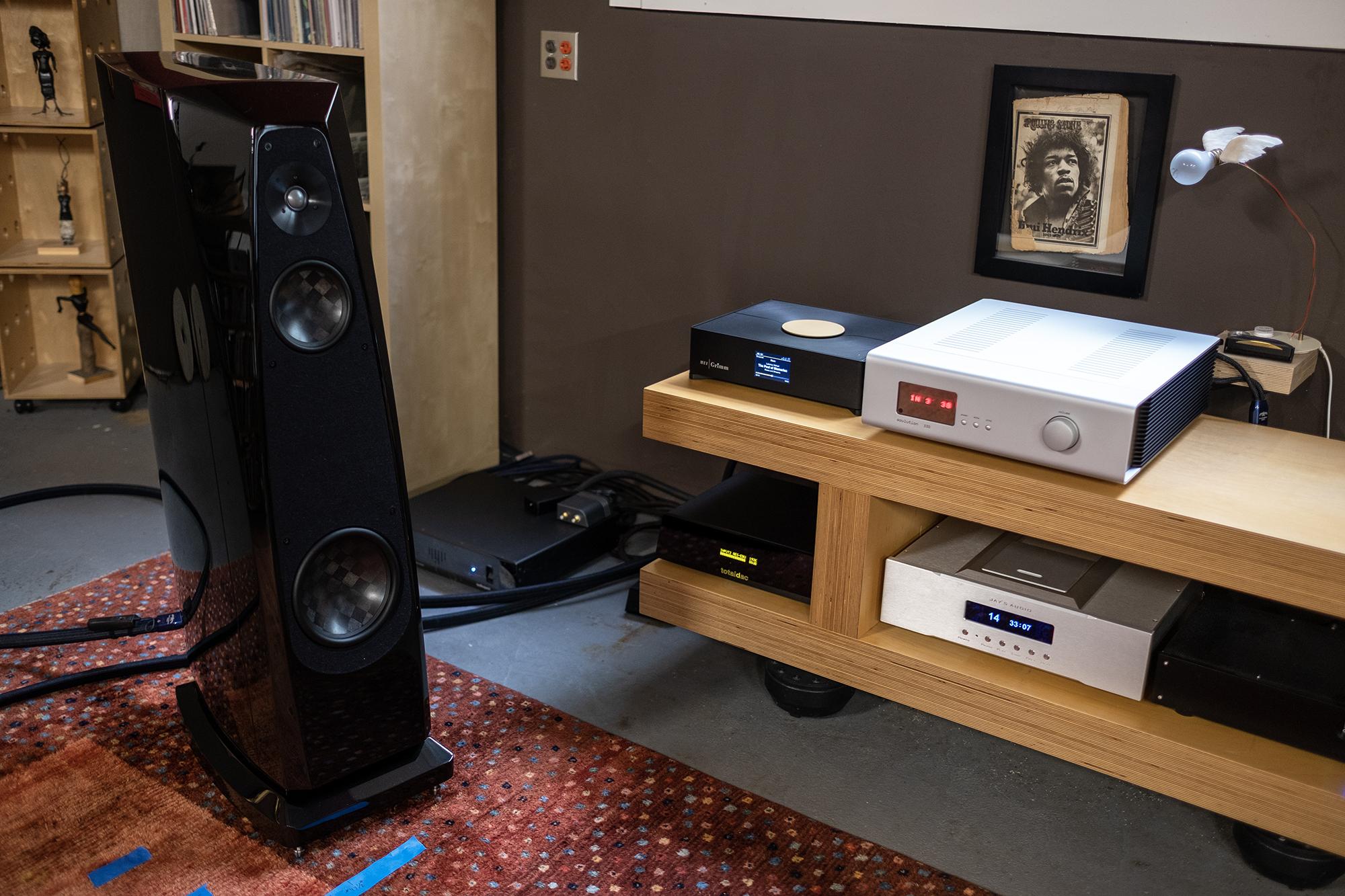
One of the aspects of the totaldac’s way with music that I find out of the ordinary, i.e. extraordinary, is it reproduces the voice of things—people, instruments, electronics, etc.—with seemingly full color and full resolution in perfect balance, which is a rare double feature in DACs in my experience. With the MU1 feeding the d1-unity in this Soulution/Rockport system, the totaldac’s strengths were magnified, sounding as if the music dancing into the Barn had been purified.
While the Auralic AIRES G1.1 is my streamer of choice in Barn, the much less expensive streamer, about 1/5 the price of the MU1, could not match this purity of sound produced by this system with the Grimm MU1 in it. But let’s remember that the MU1 is also a Roon server, so the Barn’s B-Side saw heavy action as well with the Auralic ARIES as part of other systems tapping into the MU1 as Roon server. I would not recommend buying an MU1 to use as just a server because that would be throwing away its largest positive system impact, it’s good to keep in mind that it does double duty as Roon server and streamer.
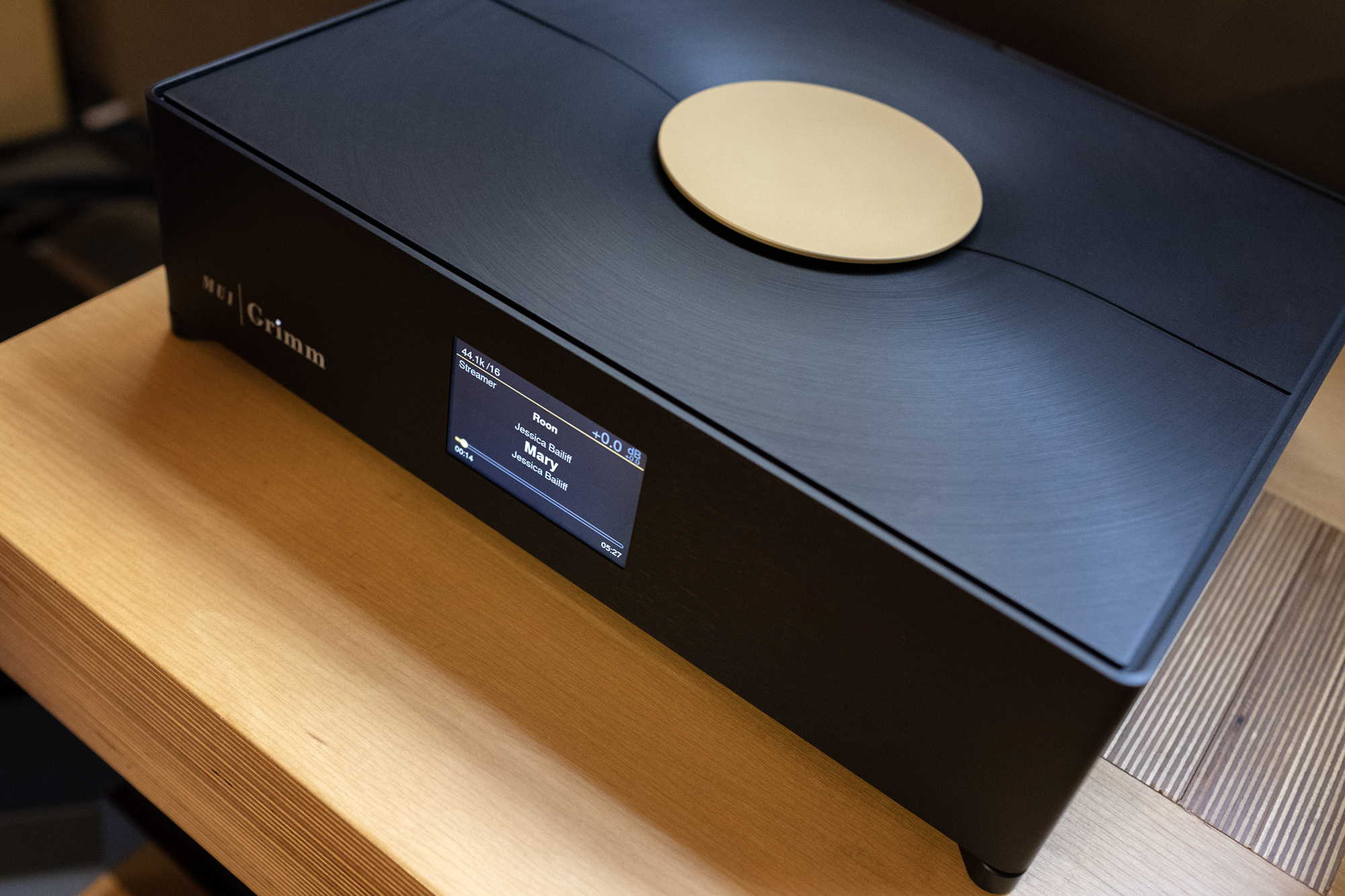
While we’re moving away from music, let’s talk about upsampling. With the Mola Mola Tambaqui, I preferred this system’s sound with the MU1’s 4fs (4x the fundamental sample rate) upsampling option engaged. So CD-quality, 44.1kHz data, which is most of the music I listen to, is upsampled to 176.4kHz. Doing so made music seem a bit more refined, a tad more fluid, and a touch richer. In the grand scheme of things, these changes were subtle but welcome. For the totaldac d1-unity, I preferred this system’s sound with the MU1’s 2fs upsampling option employed, where CD-quality data was upsampled to 88.2kHz, offering similar results as the 4fs setting with the Tambaqui. Since these settings are but a click on the browser-based interface away, as is letting data run native with no upsampling, I wouldn’t fret over this bit one bit. I also wouldn’t walk away from this review thinking that upsampling makes music sound better in any and every system no matter what gear is doing the upsampling for the same reason I wouldn’t suggest that Frank’s Hot Sauce makes all food taste better.
I recently stumbled on Jessica Bailiff’s self-titled third album, released on kranky, from 2002. You may know Bailiff from her work with Low’s Alan Sparhawk, he ‘discovered’ her, and there’s a similar stripped down quality here, a minimal haunting slow(core) pace that digs me deep into the groove. Recorded at home (don’t be afraid) with Bailiff on acoustic guitar and dreamy vocals with unspecified accompaniment from Bailiff’s Red Morning Chorus bandmates Jesse Edwards and Noel Keesee, this album unfolds gently taking great care in the tiniest details of time, timing, and sound both pure and processed. Once again, this system with the Grimm feeding the totaldac 2fs upsampled data (I hope that sounds as awkward and as it was to write), Bailiff & Co took over the Barn’s atmosphere and my attention, rendering kaleidoscopic clouds of richly portrayed haunting beauty.

As is the case with every review, the music highlighted here is but a tiny fraction of the music that graced the Barn during the MU1’s all-too-short 2-month visit. Many hours, days, and nights were spent just listening and smiling to all manner of music.

I could have danced all night, most nights, that I got to enjoy this system and the Grimm MU1’s role in it for its 2-month stay. I really didn’t need to rely on any ‘test tracks’ to suss out the finer details of the Grimm’s performance because it was just so obvious. Obvious in sound, and even more apparent in my reaction to the experience of listening where I could tap into any music I cared to play, or that Roon Radio offered, within moments of sitting in the Barn’s red chair. Music was a beautiful stream flowing through the Barn that I could dip or dive into at any time for as long as time allowed.
For anyone looking to bring more refined beauty to their music while simplifying streaming and serving needs in a single lovely to look at and lovely to use device, the Grimm MU1 is my first recommendation.
Grimm Audio MU1 Music Player
Price: $12,500 with no internal storage, +$235 w/2TB SSD storage (as reviewed), +$630 w/8TB SSD storage
Company Website: Grimm Audio
Specifications
General:
- Max. ambient temperature for operation: 40 °C.
- Fuse (worldwide): 630 mA fast blow.
- Weight: 4.5 kg.
- Dimensions: width x depth x height: 355 x 295 x 100 mm or 14” x 11.6” x 3.9”.
- Package dimensions: 540 x 392 x 235 mm.
Clock specifications:
- Internal intrinsic clock jitter < 0.6 ps RMS (> 10 Hz).
- Can slave to 44.1 kHz and 48 kHz based digital sources at 1FS, 2FS and 4FS +/- 50ppm.
- The output will mute for 80 ms when changing clock base rates.
Sample rate conversion with fpga processor:
- Upsampling of 1FS and 2FS files, streams and digital sources to 4FS or 2FS with “Pure Nyquist” decimation filter.
• Downsampling of DSD64, DSD128, DSD256 and DXD files and streams to 4FS or 2FS with “Pure Nyquist” decimation filter.
• Optional FPGA volume control on Digital 1 and 2 outputs, and S/PDIF in case no LS1 is connected: from 0 dB to -63 dB in 0.5 dB (partly 1 dB) steps. - Latency from digital in to digital out: 11 ms at 48kHz.
Power supply:
- Mains voltage range: 90 – 240 V AC (50 and 60 Hz).
- Power factor: > 0.98.
- Power consumption: Normal use 17 W, maximum 50 W.
Internal computer properties:
- Intel i3 CPU, > 2.4 GHz.
- 4 cores, 4 threads, with Hyper-threading.
- 8 GB DDR4-2133 RAM 2400 MHz.
- 1000 Mb/s Ethernet.
- 1 x USB 2.0 port.
- Internal SSD for OS.
- Optional internal SSD for music data storage.
Display specifications:
- Full color TFT LCD.
- 3.5 inch diagonal.
- 480 x 320 pixels.


